The Birth of Loop
A Short History of Looping Music
Although repetition is a major force in music it was never used in this way before
Terry Riley
Repetition is a form of change
Brian Eno
A way for one person to make an awful lot of noise. Wonderful!
Robert Fripp
This page tries to summarize the steps in the history of music which led to the distinct style and technology of Looping Music.
Looping Music today typically employs tape delay/feedback systems, digital delay devices, or computers to create repetitions of sounds. These repetitions can either remain limited to simple repeated phrases, or they are allowed to add up to a complex sound texture which either stands for itself or is used as an atmospheric or rhythmic background for soloing or other musical expression.
To varying extents, repetition has always been part of the musics of all cultures, but only in the 20th century, it became a style, a musical form of its own. Inspired by the meeting of world cultures, aided by technology, pioneered by visionary composers, looping music was born.
- The Dawn of Music
- Rise and Fall of Repetition
- 20th Century: A New Music
- Erik Satie
- Musique Concrète and Tape Music
- The San Francisco Tape Music Center
- Terry Riley
- Steve Reich
- Eno and Fripp
- Today Loops
The Dawn of Music
Vibration and regular repeating patterns are the foundation of matter and energy. On a scale more accessible to humans, rhythmic repetition, oscillation, and pulsation are dominant qualities of nature known to everyone: Waves on a shore, moon phases, day and night, the seasons, the songs of cicadas and other insects.
There is pulsation and rhythm in our own body: Heartbeat, breathing; the steady rhythm of walking that was imprinted in our genetic memory during our life as nomads.
These basic experiences of life have long ago formed our love of rhythm. While developing a sense of rhythm, our ancestors found that it is fun to sing along with the rhythm. Our first melodies were taught to us by birds and other animals, all of whom also employ repetitions in their songs: Indonesian Ketjak is a complex rhythmic monkey chant; Pygmy melodies of the African rainforests cite the songs of tropical birds.
Rise and Fall of Repetition
Repeating melodies – monotonous or based on simple harmonies – and repeating song structures became popular in all cultures, not only because their patterns were easy to memorize, but because performing them in combination with repeating rhythms had strong psychological effects and was sometimes meditative or potentially trance-inducing. (Man’s ancient fondness of spirituality and altered states of consciousness is another fascinating story.)
How Repetition Enchants the Brain and the Psychology of Why We Love It in Music
Rhythmic, repetitive musical structures eventually reached high levels of sophistication in a number of world cultures (Javanese Gamelan, Ghanaese drumming, Indian tabla, Pygmy songs, to name but a few). Some early medieval European music also employed repetition as a basic formal element, but at some point in the middle ages, music in Europe began developing into a different direction.
The discovery and elaboration of the laws of harmony in the Renaissance pushed rhythm and repetition into the musical background. In early 18th century Europe, the well-tempered 12-tone equal temperament became the dominant tuning system which it still is. The great works of classical music were complex harmonic structures which needed rhythm and repetition primarily as a means to give them a form. Rhythmic, repetitive, modal music as practised elsewhere on the planet was not known or considered primitive.
20th Century: A New Music
The beginning of the 20th century brought revolutionary paradigm shifts to many aspects of life, including music.
Adventurous composers, realizing that European music was stuck in an impasse, freed themselves of all harmonic traditions and invented new musical forms such as atonality, 12-tone music, or aleatory composing.
In 1889, Debussy watched a Javanese Gamelan performance in Paris. This experience had a profound influence on his music, and subsequently on the music of other influential composers. The discovery of non-European music systems was a turning point because it reintroduced rhythm, percussion, and repetition (as can be heard in Ravel’s Bolero) and a new sense of the importance of sound and instrumental colour.
At the same time, blues and jazz evolved and quickly turned into major musical movements, emphasizing rhythm, repetition, and improvisation.
Electronic music instruments and sound recording on gramophone records and tape were invented and gave birth to new aesthetics and completely new worlds of sound and musical structures, such as pure electronic music, musique concrète based on real-world sounds, or mixtures of both.
Erik Satie
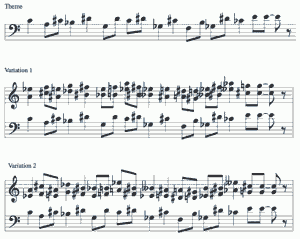 Erik Satie was possibly the most eccentric, innovative, and influential composer of the early 20th century. Of all his interesting works, two are of special interest here:
Erik Satie was possibly the most eccentric, innovative, and influential composer of the early 20th century. Of all his interesting works, two are of special interest here:
Musique d’Ameublement is often said to be the first piece of ambient music. Its first performance was given 1920 at a picture exhibition. The furnishing music, played on a piano, three clarinets, and a trombone, was performed in the gallery while people were looking at pictures.
“We beg you to take no notice of it and to behave (…) as if the music did not exist. This music … claims to make its contribution to life in the same way as a private conversation, a picture, or the chair on which you may or may not be seated …”
Vexations for piano was a forefather of Minimal music. The piece (embedded in Satie’s Pages Mystiques) consists of two lines of chromatic, diminished triads. The resulting melody has to be played slowly and takes a minute or two to play. What makes it radical minimalist music is the performance instruction to play it 840 times which can easily result in a performance time of 24 hours. The first performance of Vexations which took the instruction seriously was given in 1963 by John Cage who had discovered the piece in Satie’s heritage several years earlier.
Musique Concrète and Tape Music
The gramophone record, invented 1887, was the first medium which could store and playback sound. The invention of magnetic sound recording dates back to 1898 – steel wire was used for the first machines. A tape recorder using oxide-coated plastic tape was invented in 1935, but didn’t become available for most studios until the late 1940s.
Between the World Wars, several composers (Milhaud, Hindemith, Varèse, Cage and others) used gramophone records and variable-speed turntables to create new kinds of music based on prerecorded sound. The first loops were done on gramophone records.
After the second World War, a number of gramophone record based works of musique concrète were written (e.g. by Pierre Schaeffer (1948), Olivier Messiaen (1952), and some of Messiaen’s pupils such as Boulez and Stockhausen).
The beginning of the fifties brought the first tape music compositions (the first one being Edgard Varèse’s Deserts (1954)), based on the new possibilities for sound modification using tape recorders. Tape music composers (such as John Cage, Edgard Varèse, Karlheinz Stockhausen, Mauricio Kagel, and others) used tape recorders to change the speed of sounds, or reverse, edit, and superimpose them. Pre-existing sounds could be altered, combined with electronic sounds and real instruments, or assembled into collages.
In the late fifties and early sixties, composers started to use tape recorders and other electronic sound equipment for live performances. At the same time, electronic music and tape music studios were founded in several cities (such as Paris and Cologne) and became important centers for the new music.
The origin of tape loops is not entirely clear. There is no known “inventor” of this technique, but the simple idea to take a piece of recorded tape and splice it into a closed loop, producing static repetitions of a sound, probably goes back to the inventors or first users of the tape recorder. Outside the avantgarde music scene, tape loops were soon used in radio studios and in the film industry where they were employed for synchronisation and soundtrack purposes.
In the late 1960s, the hypnotizing effect of repetitions made tape loops popular in psychedelic rock music. The Beatles’ Paul McCartney was inspired by the creative use of tape loops in Stockhausen’s music and experimented with this technique in the 1966 piece “Tomorrow Never Knows”. Read all about it here.
In 1969, the British avantgarde Jazz/Rock band The Soft Machine created a whole album of abstract tape loop based soundscapes. “Using tapes that I had made of the band [Soft Machine] in concert, together with material composed especially for the occasion, ‘Spaced’ was created in the living room of my […] apartment. Many tape loops were involved, ranging in length from just a bar or two, to several minutes, with the loops run around milk bottles on the stairs, and requiring retraining the cat to prevent her leaping on each loop as the splicing tape slid by.”
(Bob Woolford in the liner notes to Soft Machine’s “Spaced”)
Tape delay exploited the short distance between a tape recorder’s record and playback heads. As soon as tape recorder technology became widely available to studios, sound engineers and musicians such as Les Paul started to build machines that could produce a short echo. In the early 1950s, small and portable tape delay machines with a closed tape loop and adjustable head positions were developed. The sound of tape delay became the trademark sound of early rock ‘n roll music.
In avantgarde music, composers such as Stockhausen built more elaborate tape delays that involved long tapes running through several tape recorders, producing very long delays.
“What is played is sometimes recorded by microphone onto tape, according to the instructions. The recorded events are copied – superimposed – in different polyphonic patterns, and are played back over loudspeakers at the moments indicated, as the soloist plays. In Tokyo, a table was built which had adjustable guide rollers for changing the time-delay of the tape playback. For following performances, 7 tape recorders were used, through which the same tape ran. The first feedback apparatus especially for SOLO was built at the Studio for Electronic Music in Utrecht.”
Mr Müller (former assistant of Stockhausen) performing on generator, radio and 3 tape machines from standuino on Vimeo.
A tape delay/feedback system based on two tape recorders was invented by an anonymous sound engineer who worked for Terry Riley during the Paris sessions for Riley’s Music for The Gift in 1963. Of course, this invention drew upon previously invented tape techniques such as closed tape loops and tape delays, especially tape delays involving several tape recorders, but it introduced a simple and elegant new way to control feedback and long multiple delays of live audio input – livelooping was born. (More about this in the following paragraphs.)
The San Francisco Tape Music Center
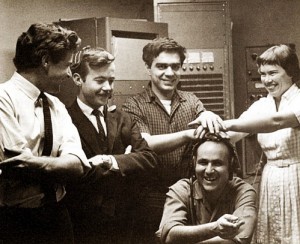
Tony Martin, Bill Maginnis, Ramon Sender, Morton Subotnick & Pauline Oliveros (image by Folke Rabe, from an interview with Ingvar Loco Nordin)
In the early 1950s, the Pacifica Foundation Listener Sponsored Radio Station KPFA in Berkeley, led by Robert Erickson, was one of the few alternative stations which played avantgarde tape music, inspiring many young Californian composers. KPFA actively supported such composers (such as Pauline Oliveros who played in an improvisation band with Terry Riley and Loren Rush) by recording and presenting their work.
In 1960, KPFA director Erickson began organizing composers’ workshops at the San Francisco Conservatory of Music. A year later, participants of these workshops (Ramon Sender and Morton Subotnick) founded the San Francisco Tape Music Center. (More information with music examples here)
In the first seven years, the Center, directed by Pauline Oliveros, became a lively meeting place for the Californian avantgarde scene and gave birth to the influential musical movement of minimalism. Pauline Oliveros and Terry Riley became pioneers for tape loop techniques and tape delay/feedback systems.
In her later musical career, Pauline Oliveros focused her research on environmental sounds, consciousness, meditation, and the process of perception and listening.
Terry Riley emphasized an open, modal, pulsating, improvisational kind of minimalism and got deeply involved with classical Indian music.
Here is a short article about the Center with music examples.
Terry Riley
Terry Riley was one of the key figures of minimalism and the most important pioneer of tape loops and tape delay/feedback systems.
In the 1950s, he made a living as a solo piano player in bars where he learned how to improvise and engage an audience. Between 1955 and 1961, he studied composition and piano in San Francisco and Berkeley. Fascinated by Coltrane and influenced by John Cage, he became involved with open improvisation and avantgarde music.
Mescalin Mix, Riley’s earliest tape based musique concrète piece (1960), was written for the Anna Halprins Dance Company and consisted of closed tape loops containing various real-world sounds.
Music for The Gift (1963), written for a play by Ken Dewey, was the first piece ever based on a tape delay/feedback system with two tape recorders – a setup Riley used to call the “Time Lag Accumulator”. The source material for Riley’s loops consisted of recordings he made of the Chet Baker quartet playing Miles Davis’s So What. It was this looping piece which got Riley really interested in repetition as a musical form, leading the way to his breakthrough as a minimalist composer and performer.
“The accumulation technique hadn’t been invented yet and it got invented during this session [on July 9, 1963]. I was asking the engineer, describing to him the kind of sound I had worked with in Mescaline Mix. I wanted this kind of long, repeated loop and I said, ‘can you create something like that?’ He got it by stringing the tape between two tape recorders and feeding the signal from the second machine back to the first to recycle along with the new incoming signals. By varying the intensity of the feedback you could form the sound either into a single image without any delay or increase the intensity until it became a dense chaotic kind of sound. I enjoy the interplay between the two extremes. This engineer was the first to create this technique that I know of, this began my obsession with time-lag accumulation feed-back. It took me quite a while before I could afford to buy two good tape recorders to run this process in my own studio.”
This tape technology that made livelooping possible eventually evolved into Frippertronics and digital loop delays.
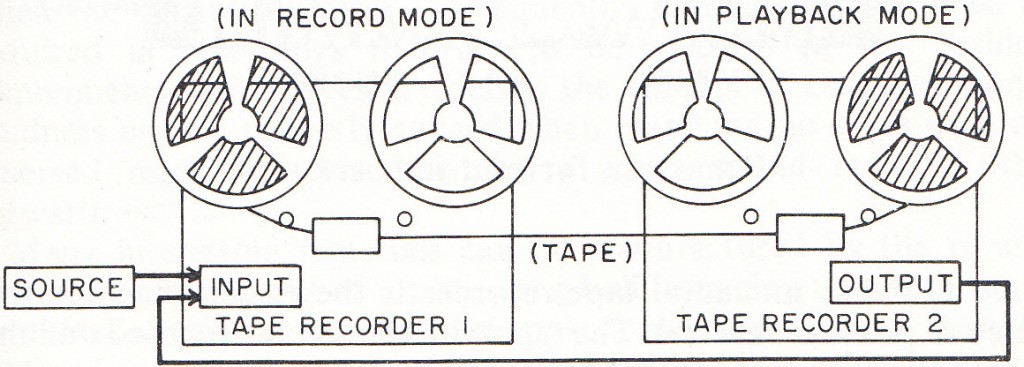
Tape Echo on 2 Machines, from: David Keane: Tape Music Composition, 1980
Riley learned to play the saxophone and became famous for his all-night flights, extended solo improvisation concerts for keyboards, saxophone, and the Time Lag Accumulator tape delay. His most successful recordings, A Rainbow in Curved Air (1969) and Poppy Nogood and the Phantom Band (1968), were based on excerpts of these all-night concerts.
“I did a solo all night concert which started at 10:00 at night and ended at sunrise. People brought their whole families and they had their sleeping bags and hammocks. It was in one of the big rooms in art college. It started out a career for me doing all night concerts which I did for a couple of years. I really didn’t have a plan, I just went in and started playing. One of my specialties was to be able to play for a really long time without stopping and I would play these repeated patterns for hours and hours and I wouldn’t seem to get tired. I guess I have a lot of energy. Throughout the evening I would be recording these long saxophone delays and about four hours into the concert, if I wanted to take a break I would just play back the saxophone. And a lot of people didn’t even wake up to know the difference because a lot of people just slept all night.”
Riley’s “classical” and most well-known minimalist piece was In C.
“Well I guess my music came to prominence around one piece called In C which I wrote in 1964. At that time it was called The Global Villages for Symphonic Pieces, because it was a piece built out of 53 simple patterns and the structure was new to music at that time. No one had done anything like this before where you just had a piece built all out of patterns and the first concerts of In C were kind of big communal events where a lot of people would come out and sometimes listen or dance to the music because the music would get quite ecstatic with all these repeated patterns. Although repetition is a major force in music it was never used in this way before. So, essentially my contribution was to introduce repetition into Western music as the main ingredient without any melody over it, without anything, just repeated patterns, musical patterns. In the nutshell, that was my own introduction into the world of western music.”
Influenced by his friend and minimalist composer La Monte Young, Riley got interested in drones and Indian music. Both studied with Pandit Pran Nath, a teacher for classical Indian vocal music. (Among Pran Nath’s other students were Don Cherry and Jon Hassell.) Riley eventually abandoned the saxophone and concentrated on using his voice instead. In his later works, Riley returned to playing the piano, using just intonation tuning systems, and composed pieces for the Kronos String Quartet.
Steve Reich
Only one of the minimalist composers – Terry Riley – concentrated on tape delay based improvisation. Steve Reich did some tape based pieces as well, but he was never interested in improvisation, and did not use tape machines for delay effects. His early instrumental work and especially his tape pieces It’s Gonna Rain (1965) and Come Out (1966) are examples for what Brian Eno would call Systems Music – they are based on simple rules which build up a complex structure, ideally without human intervention at all.
“The idea of using constant repetition partially grew out of working with tape loops since 1963, but mainly through helping Terry Riley put together the first performance, in 1964, of his In C, where many different repeating patterns were combined simultaneously. My problem was then to find some new way of working with repetition as a musical technique. My first thought was to play one loop against itself in some particular canonic relationship since some my previous pieces had dealt with two or more identical instruments playing the same notes against each other. In the process of trying to line up two identical tape loops in some particular relationship, I discovered that the most interesting music of all was made by simply lining the loops up in unison, and letting them slowly shift out of phase with each other. As I listened to this gradual phase shifting process I began to realize that it was an extraordinary form of musical structure. This process struck me as a way of going through a number of relationships between two identities without ever having any transitions. It was a seamless, continuous, uninterrupted musical process.”
Influenced by African and Indonesian music, Reich’s phase shifting and repetition ideas grew more complex. His more famous pieces such as Six Pianos (1973) consist of interlocking, slowly changing, polyrhythmic and harmonic patterns. Eventually, Reich abandoned strict minimalism and proceeded to more complex structures, although he still used polyrhythms and repetition.
A later recording, The Cave (1995), concentrated on rhythmic and harmonic structures of speech patterns.
(Quotations taken from Reich’s book Writings about Music)
Eno and Fripp
Brian Eno was always fascinated by tape recorders and the different things one can do with them.
“I had wanted a tape recorder since I was tiny. I thought it was just like a magic thing, and I always used to ask my parents if I could have one but I never got one, until just before I went to art school I got access to one and started playing with it, and then when I went to art school they had them there. I thought it was magic to be able to catch something identically on tape and then be able to play around with it, run it backwards; I thought that was great for years.”
Eno got equally fascinated with minimalist music, especially with Steve Reich’s It’s Gonna Rain. Eno’s important Systems Music idea can be traced back to this piece.
“I was so impressed by this as a way of composing that I made many, many pieces of music using more complex variations of that. In fact all of the stuff that is called ambient music really — sorry, all the stuff I released called ambient music, not the stuff those other 2 1/2 million people released called ambient music, — all of my ambient music I should say, really was based on that kind of principle, on the idea that it’s possible to think of a system or a set of rules which once set in motion will create music for you.”
(Quotations taken from a talk given by Eno about Generative Music.)
During his experimentation with tape techniques, Eno eventually rediscovered Terry Riley’s Time Lag Accumulator, a tape delay/feedback system based on two Revox tape machines. In September 1972, Eno invited Robert Fripp over to his studio and presented this system to him. Fripp, who had no knowledge of minimalist music, plugged his guitar in and started to play without much introduction to the system, and without rehearsing. The result was a classical tape delay recording, called The Heavenly Music Corporation, contained on the (No Pussyfooting) LP (1973).
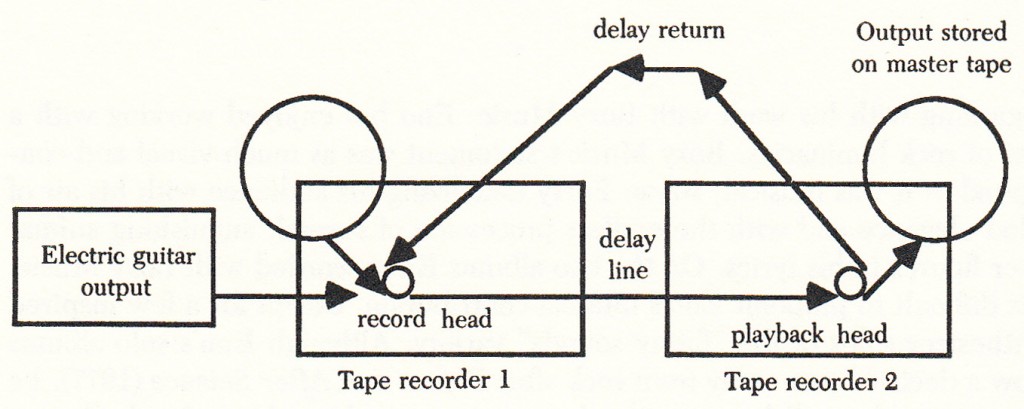
Eno and Fripp’s Signal-Delay System Used For “(No Pussyfooting)” – from: Eric Tamm, Brian Eno – His Music and the Vertical Color of Sound
Eno’s and Fripp’s biographer Eric Tamm says:
“No Pussyfooting was a major point of departure for both musicians, and Fripp seemed to recognize it instantly as such: “There it was, a way for one person to make an awful lot of noise. Wonderful!” So much did Fripp like The Heavenly Music Corporation that when King Crimson went on the road in the fall of 1972, he would play the tape before the band came onstage and after they left.”
Eno used the tape delay technique on his recording Discreet Music (1975) and on a second Fripp collaboration, Evening Star (1975). Eno’s later ambient work returned to using systems of several closed tape loops of different lengths, e.g. in Ambient Music 1 – Music for Airports (1978) and in his video installations.
Fripp continued using the tape delay/feedback technique in his work with Peter Gabriel (1976) and Daryl Hall (1977) and on his solo record Exposure (1978). In 1979, Fripp began to give solo concerts for guitar and tape delay, a setup he called Frippertronics. His recordings Let the Power Fall (1981) and God Save the Queen (1981) were solo Frippertronics LPs. For Fripp, Frippertronics was a powerful way to open himself up for music and to explore new musical territory.
“I was soloing over the Frippertronics loop and I heard the next note and played it, and I was weeping as I was playing because something was beginning to move.”
(Quotations taken from Tamm’s book Robert Fripp)
In the 1980s, Fripp concentrated on minimalist style patterns, a new guitar tuning, and his Guitar Craft teaching, using tape delays only now and then.
In the early 1990s, he rediscovered the technique during his constant search for fresh and new ways of musical expression. The next incarnation of Frippertronics was called Soundscapes and employed a growing array of sophisticated digital machinery, such as guitar synthesizers, digital looping devices, and Eventide harmonizers. He played solo Soundscapes concerts (as can be heard on 1999 – Soundscapes live in Argentina (1994), for example) and integrated Soundscapes into his group work with the Robert Fripp String Quintet (1993), the G3 project with Vai and Satriani, and his own band King Crimson, as well as the duo project with Theo Travis.
Due to Fripp’s quasi-cult-status as King Crimson guitarist, the Frippertronics and Soundscapes tours and records brought the idea of looping to many musicians’ attention. Former Guitar Craft student Markus Reuter performed his own version of digital Soundscapes during numerous live shows with Stick Men, a trio with King Crimson members Tony Levin and Pat Mastelotto, and he recorded a number of solo Soundscapes albums. Reuter is one of probably thousands of guitarists worldwide who recognized the musical potential of livelooping for solo guitarists, inspired by Robert Fripp. In the growing livelooping community, Fripp inspired solo guitarists are probably the largest fraction.
Today’s Loops
Computers are today’s music tools. Repetitions of sounds are no longer done by tape loops – today’s computer based music production, especially popular music, is extensively cut & paste based, repetitions and copies of musical material are ubiquitous and seamlessly integrated. Nowadays, a “loop” is just a repetition of a prerecorded sample (in live music) or of a part of a multi-track recording (in the studio), and because loops are so ubiquitous, they have become more or less invisible as a distinct phenomenon. The word “loop” has moved as far away from its original meaning as the word “bug” in computer programming.
Livelooping, however, has remained a special case. There is a distinct kind of minimalist aesthetic to the slow building up of musical layers while older layers fade away – this method creates a unique kind of music that has not lost its appeal since Terry Riley’s Rainbow in Curved Air. Digital livelooping machines and software, replacing the old tape technologies, have became quite powerful and sophisticated – the old hypnotic minimalist livelooping style can still easily be created, but there are now many additional kinds of musical aesthetics and styles that can be produced by livelooping, and more keep getting invented.
Because the tools have become so affordable (or even free), livelooping music turned into something many people could do. A rapidly growing number of musicians experiment with this technique, the livelooping scene is very alive with many concerts and festivals, more and more “loopers” and livelooping stompboxes hit the market, and livelooping turns up on many different recordings, often seamlessly integrated into “regular” music.
When I wrote the first version of this essay, I concluded with “will livelooping remain a rare phenomenon, or will it be an integral part of the music of tomorrow?” It seems quite clear now, 16 years later, and 50 years after its invention, that livelooping is here to stay.
Books
| Michael Nyman | Experimental Music: Cage and Beyond | Studio Vista, 1974 |
| Steve Reich | Writings about Music | New York University Press, 1974 |
| Paul Griffiths | A Guide to Electronic Music | Thames and Hudson, 1979 |
| David Keane | Tape Music Composition | Oxford University Press, 1980 |
| Pauline Oliveros | Software for People Collected Writings 1963-1980 | Smith Publications, 1984 |
| Eric Tamm | Brian Eno His Music and the Vertical Color of Sound | Faber and Faber, 1989 |
| Eric Tamm | Robert Fripp From King Crimson to Guitar Craft | Faber and Faber, 1990 |
| Edward Strickland | American Composers | Indiana University Press, 1987 |
| Edward Strickland | Minimalism: Origins | Indiana University Press, 1993 |
| David Toop | Ocean of Sound Aether Talk, Ambient Sound and Imaginary Worlds | Serpents Tail, 1996 |
| David W. Bernstein, ed. | The San Francisco Tape Music Center 1960 Counterculture and the Avant-Garde |
University of California Press, 2008 |
Links
| The Birth of Loop
(Enhanced version) |
This article has been reblogged by Miguel Copón on his ‘Prepared Guitar’ site. Miguel has added many photos and videos |
| The greatest electronic albums of the 1950s and 1960s | The great electronic albums of the 1970s get plenty of kudos – but what of their predecessors? Written by Joseph Morpurgo |
The Birth of Loop (c) Michael Peters
Version 2.0 (created Oct 13, 1996, modified now and then since)
(Comments, corrections and additions welcome. Send email)

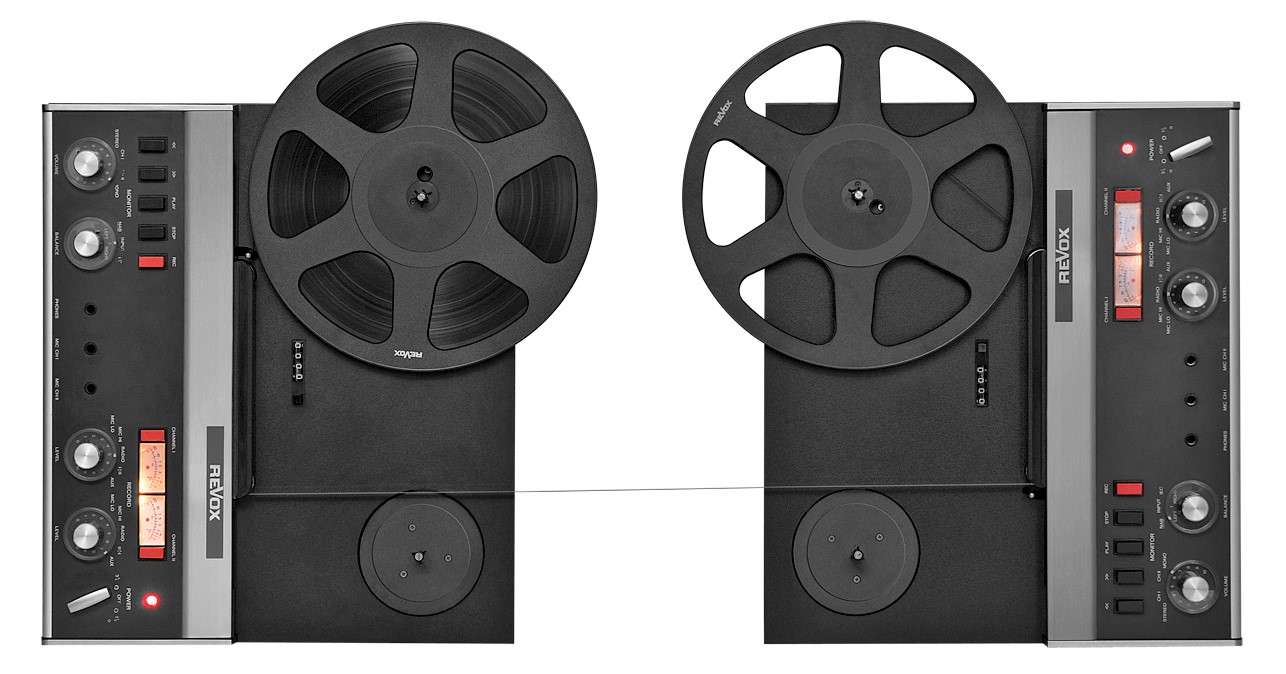
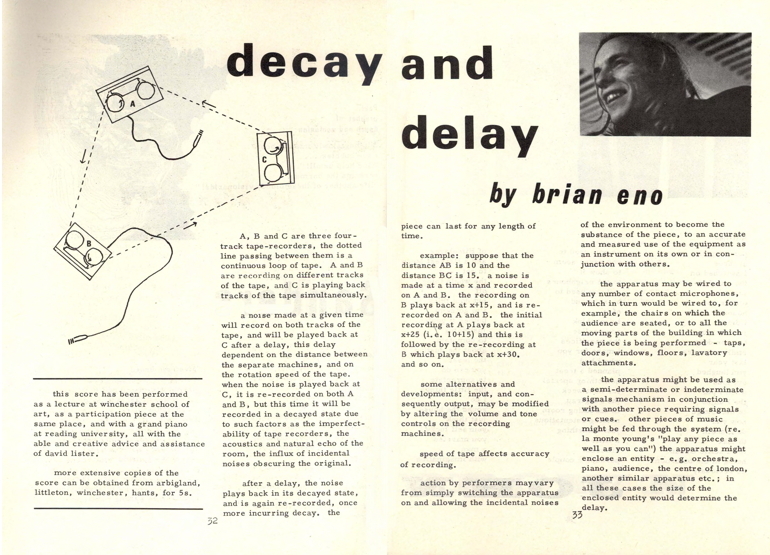
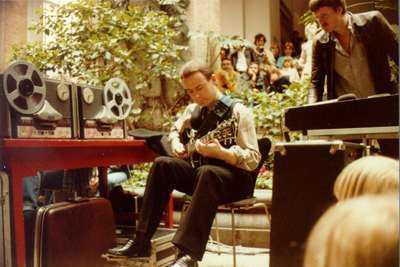
Comments
Michael Peters: The Birth of Loop (1996-) — No Comments
HTML tags allowed in your comment: <a href="" title=""> <abbr title=""> <acronym title=""> <b> <blockquote cite=""> <cite> <code> <del datetime=""> <em> <i> <q cite=""> <s> <strike> <strong>